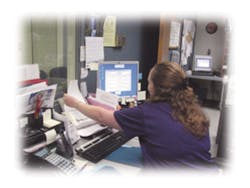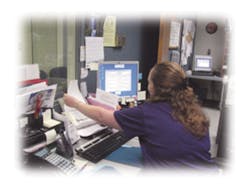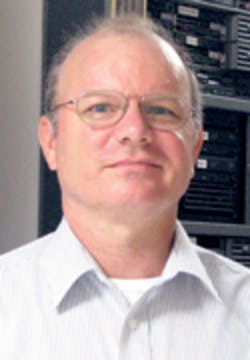A document management solution enhances the quality of care for a Kansas medical center.
The volume of paperwork in the healthcare field can often keep employees from focusing on primary patient care duties, and slow paper processes often delay important decisions. As our patient traffic increased at Mercy Regional Health Center (MRHC), we were wasting an incredible amount of time and money managing paper. Transferring documents between MRHC’ s five locations was taking up to three days and the paper overflow turned productive work areas into storage space. Time, money and other valuable resources were being spent on photocopying 1.25 million pages of medical records and on their delivery to doctors’ offices by mail or fax. Our paper-based system was a burden to our staff, the quality of our services and a drain on our budget.
A document management solution enhances the quality of care for a Kansas medical center.
Initially, we wanted document scanning capability solely for archiving purposes, but it soon became clear that we had millions of documents across the enterprise to organize and manage, and we needed an easy way to get people the documents they needed, when they needed them. Our IT department worked with a team of professionals from Medical Records and Patient Accounts to select a solution that could be utilized throughout the medical center. The ability to integrate with our Meditech system was critical, but we also needed a system that could stand on its own in areas such as our contracts department.
After five months of discussions with vendors, we selected ImageNow, an enterprise document management, imaging and workflow solution developed by Perceptive Software Inc. ImageNow integrates with any application, which makes it perfect for enterprisewide deployments such as our own, and we knew that it would be compatible with any new host software we purchased, regardless of version or vendor. The easy integration capabilities offered by the solution gave us the flexibility we were looking for to start in one area and gradually roll the system out to other departments on our own, and the cost was lower than the other proposals we were given by competing vendors.
The Rollout
Located in Manhattan, Kan., Mercy Regional Health Center is a private, not-for-profit acute-care facility with three clinics and 150 beds in two hospitals. MRHC employs 1,000 physicians and staff throughout five locations serving the people of Manhattan and the surrounding areas.
We implemented ImageNow first in the medical records department. In a matter of weeks, planning and implementation were complete, and we were scanning-in paperwork as it arrived. We originally thought we could get by with some inexpensive, entry-level scanners, but they didn’ t provide us with the capability to scan ID cards and were too slow to scan multipage documents while patients waited. Within two months, we decided to upgrade to more expensive scanning stations to handle our high volume of documents— these units ran approximately $1000 apiece.
For more information
ImageNow and other
Perceptive Software solutions,
www.rsleads.com/709ht-207
Since the initial implementation in 2004, we’ ve continued to expand ImageNow into other departments such as admissions/registration, patient accounting, ER, billing, pain clinic, radiology, sleep laboratory and the contracts department. The solution also is used for managing documents within our IT department for compliance regulations. We now have 56 point-of-contact scanning stations across our facilities and more than 5.4 million documents in the ImageNow repository since we began scanning incoming documents.
We have scanners currently deployed at all points of registration throughout our facilities, including the pain clinic, wound care center, sleep lab and Occupational Health. Technical areas such as Radiology, labs and pharmacy have dedicated scanners of their own. Non medical areas such as MIS, use the scanners for HIPAA access forms, while the CFO’ s office utilizes them to scan contracts and capital equipments requests. We found that scanning in each of these areas speeds administrative processes and eliminates a backlog of scanning in any one area. Plus, employees like having everything nearby without having to move around.
Simplified Admissions, Billing Cycles
After the deployment, a colleague and I attended a training seminar at Perceptive Software’ s headquarters, which allowed us to bring back information, training materials and knowledge that we were able to share. We adopted a train-the-trainer approach with our staff that we’ ve been able to maintain as we continue to roll out ImageNow. With the knowledge we acquired, and because the system is so easy to use, we can train users in five minutes, even if they’ re not proficient with computers or technology.
Now, when a patient registers at MRHC, an associate scans consent forms, an insurance card, HIPAA security forms and other documents into ImageNow. The patient’ s information is then immediately available to employees in other areas directly from our Meditech system. We’ ve greatly reduced photocopying and filing in Admissions, which allows workers to focus on other duties and not have to worry about losing track of records. All documents are shredded after scanning, and consequently, much of our old storage space has been converted into productive office space.
Before we implemented the system, each time a patient was admitted to an MRHC facility, an accounting associate created a folder that contained admissions documentation. Now, consolidating each patient’ s documents into one electronic file in ImageNow simplifies data retrieval. Rather than manually routing explanations of benefits (EOB), our billing department scans them into ImageNow. A processing agent recognizes the payees’ last names and then automatically routes an EOB link to the associates’ work queues, eliminating photocopying.
By linking EOBs to individual patient accounts, we’ ve expedited the billing process. With paper documents, we multiplied each EOB several times, costing us time and money. In fewer steps, the billing cycle is now significantly faster, makes EOBs immediately available to everyone that needs to see them and saves us thousands of sheets of paper. ImageNow also allows us to easily mask other patients’ information on the EOB, providing us with enhanced privacy control and the ability to meet HIPAA requirements.
Bottom-Line Benefits
We’ ve seen positive results from ImageNow across the entire enterprise in the forms of elevated productivity, savings in storage and office supplies, faster patient care, higher quality service, easier compliance with government regulations and more efficient processes. Each year, ImageNow saves us $40,000 on archival and $10,000 on medical records folders and has reduced onsite storage overhead by $37,000. Since the implementation of ImageNow, we’ ve seen a 30-40 percent increase in productivity in the billing department and a 60-70 percent increase in invoice processing in Patient Accounting.
This was measured by the amount of time saved by eliminating the manual process of creating physical patient accounts folders, collecting folders, transporting them from all our sites and the elimination of photocopying documents. Our billing clerks now have everything from our Meditech system and ImageNow right in front of them on dual monitors, which saves them time previously required for document retrieval. Any documents they need can be immediately retrieved directly from Meditech and displayed in ImageNow.
The patient accounting office has seen a dramatic increase in efficiency, created more space, eliminated the cost of purchasing 20,000 folders each year and reduced the amount of time spent manually processing paper files. ImageNow also gives us the ability to store millions of documents in the same space as two paper notebooks, instead of monopolizing several rooms at the cost of $140 per square foot. Because of these efficiency increases, the medical records department recently moved into a new office— designed with minimal storage space.
Easier Access, Better Care
In addition to the direct cost savings ImageNow has provided, improvements in employee productivity and to the quality of care have been huge benefits to our patients and to our organization. Expanding ImageNow into nine clinical and administrative departments has provided our approximately 1,000 MRHC employees with immediate data access. Being able to simultaneously view documents facilitates real-time collaboration that was impossible before with our paper-based system. We’ ve improved security of patient records because ImageNow lets us index and organize documents the way that makes sense for each area, and access is controlled on a need-to-know basis for like documents. Clinical staff, including physicians and nurses, can only see their own patient’ s records because access is controlled through our Meditech system. Billing clerks only see billing information and the CFO’ s office can only view contracts. Our document security capabilities will become even more enhanced after we upgrade to the latest version of ImageNow.
The ability to collaborate without administrative distractions and delays allows staff members to deliver faster patient care, and the system makes our employees’ jobs easier, gives them accurate information and the peace of mind of an audit trail. One employee said that before ImageNow, she only completed 75 percent of her tasks each day because of the time spent manually processing documents. Now, she finishes everything and helps new hires with their workloads. We’ ve also found ways to off-load high-volume scanning responsibilities to departments with downtime, such as the sleep lab, which takes the burden of scanning stacks of documents from busy places like Medical Records.
When relying on hard copies, staff in multiple areas at MRHC contacted the medical records department to request patient information. Now, there is no need for these requests, as ImageNow gives users enterprisewide instant document access.
If a patient is discharged on Monday and readmitted on Thursday, clinical associates instantly retrieve the updated patient record in ImageNow, rather than waiting for someone in Medical Records to find a file that may be incomplete. This allows us to deliver appropriate treatment immediately.
The decision to go with a document management system that could grow with us has changed the way we do business, and our employees can’ t imagine going back to paper-based processes. Most importantly, the system allows employees to focus on their primary tasks without being bogged down with paperwork, which ultimately makes them more effective in their jobs, whether they’ re treating a patient, answering a billing question or managing a contract.
SEPTEMBER 2007
Mercy Regional Health Center.





